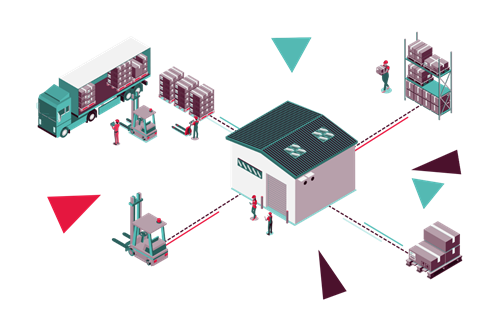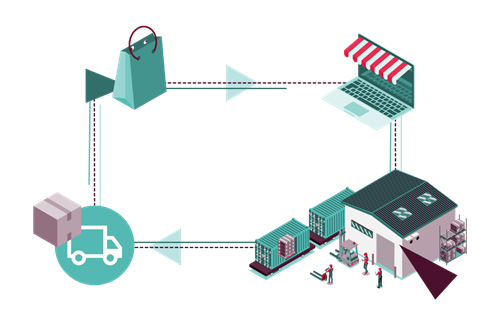How to Overcome Challenges in Warehouse Management Using Software
Warehouse management covers every aspect of running a warehouse, from organisation and management to the maintenance of all processes to ensure they run as smoothly and efficiently as possible. Despite the increasing use of automation, every operation in the warehouse is vulnerable to errors and challenges.
In 2019, a report by McKinsey & Company estimated that worldwide warehousing operations cost companies about €300 billion each year, and this is likely to be much higher in 2023 with the growth of e-commerce. What’s more, that amount doesn’t include the additional costs warehouses spend on correcting mistakes.
What are the challenges of warehouse management and how do you overcome them?
Warehouse management challenges are varied and can arise at any point along the chain of processes, affecting speed, efficiency, productivity, and even customer satisfaction. Unfortunately, errors are only spotted once the process has begun or even once it has been completed, at which point it is usually too late to prevent it or even reduce the impact.
In this article, we will explore the various challenges and common problems faced in warehouse management and demonstrate how to overcome them.
Poor warehouse layout
If your warehouse layout is messy or inefficient, it may be inadvertently harming your warehouse management. Not having enough storage because of ineffective use of space is a common challenge for warehouses across the globe, impacting efficiency and profitability as a result.
Being able to optimise your warehouse layout is the ideal solution for overcoming this problem. This can be achieved by maximising both floor and vertical space while leaving it clear for warehouse employees to pass through and operate in. It also involves exploring opportunities for automation and equipment to reduce the reliance on physical labour, reducing labour costs as well as improving the accessibility of products in the warehouse, having an efficient inventory categorisation system, and ensuring that stock is stored safely.
The most effective way of optimising warehouse space is investing in technology such as a warehouse management software (WMS). Some WMS systems have the capability to calculate and display a 3D model of your warehouse in the most optimal arrangement.
If you aren’t ready to invest in new technology, you can also use your existing solution or data to calculate which items from your inventory are selling the quickest. With that knowledge, you can then store those items in the most easily accessible locations for faster picking and putaway.
Excessive travel times
It is estimated that warehouse employees spend over half of their time travelling across the warehouse instead of performing tasks that add value to the business. By studying travel time data, warehouses can identify opportunities to rearrange picking or processing locations based on whether the items require a vehicle or manual picking. In an optimal warehouse layout, vehicle picking locations should be situated further away, with on-foot bin locations closer to processing areas.
Measuring travel time is particularly important if you are coming towards the end of your lease as this is the time to decide whether you need to move into a larger warehouse to store more goods which may have the inadvertent effect of increasing travel times for employees.
Stock damage
Damage is always a common challenge in warehouse management, and this is especially true for ones that store and handle large amounts of inventory and heavy-duty equipment. While completely avoiding damage is an impossible task, there are ways to reduce frequency.
The first port of call is to install protective gear such as pallet rack protectors, special nets for racks, guard rails, anti-slip tape, lockout systems, low clearance warning bars, and accumulation conveyor systems. Other steps include ensuring pathways are well-lit and sufficiently wide for moving products around. Not only will taking these steps protect the inventory you are storing, but also keep your employees and equipment safe and help reduce and prevent accidents in the workplace.
Regular inspections will help identify early signs of damage to equipment, storage units or transportation vehicles. It is especially important to check storage shelves and pallets for overloading, cracks and breakage. Other damage to look out for is water damage and any evidence of pests - problems that may lead to much more severe consequences later down the line if left unresolved.
Poor inventory management
Poor inventory management can manifest itself in a number of warehouse challenges. Are your staff expecting to find a product in one location only to find it’s actually stored elsewhere? Have you accepted an order on the assumption there is stock to fulfil it, only to find you actually don’t, leading to a backorder and significantly delaying the lead time? Or opposite to that, had to refuse an order assuming that you don’t have enough stock to fulfil it, only to discover you actually do. Are you having trouble finding where to put away stock that you’ve just received?
Any of these problems are an indication your inventory management is below par and is harming your operational efficiency as a result. Manual inventory checking opens the door to human error and miscalculations. This can even happen with software if it is outdated.
The best way to deal with this is to invest in a new solution that handles inventory management. This may be a standalone inventory management system, or a complete warehouse management software package that includes real-time inventory management features, such as Mintsoft. This works by collating all inventory data through a fixed or handheld device such as a barcode scanner, where the information is then sent immediately to the software system that catalogues and tracks all inventory.
Lack of preparedness for seasonal demand
Some products may experience the same amount of demand year-round, whereas others are more popular during specific times of the year. Garden furniture is a good example, where sales are much higher in the months during and leading up to summer.
Sudden influxes of demand and orders that haven’t been prepared for can harm your warehouse operations if you are not prepared to take on the number of orders. This could be due to a lack of stock or because you do not know where to store the products on such short notice. Having a good grasp of market trends and fluctuations in demand for the products you handle is essential for effectively managing changing stock levels.
To prepare for seasonal demands:
- Staying in contact with your manufacturers, distributors, retailers and transport companies is essential for maintaining information across the supply chain about demand fluctuations and working together to prepare accordingly.
- Demand forecasting allows you to calculate what products you should stock and the amount for the season coming up.
- Rearrange your warehouse to help you push out seasonal products faster. This involves placing them in the most convenient locations for efficient picking and put away.
- Automation tools and equipment such as pallet flow rack systems, forklift trucks, and AS/RS for smoother and faster processes.
Inadequate order management
Order management is one of the most crucial elements in a smooth warehouse operation. Despite this, it is one that reports the most errors. It consists of all the processes that start the minute an order is received, from accepting the order to picking, packing, and shipping the right products to the right customer, and handling post-sales processes like refunds and returns if required. An error during any one of these processes can delay, or at worst, completely collapse the entire workflow, wasting time and money.
To ensure orders run smoothly, a lot of businesses invest in an order management system (OMS). An OMS helps you manage overall order management and fulfilment processes, including shipping, customer notifications and even inventory management with certain types of systems.
High labour costs
Many tasks in the warehouse use human labour such as cleaning, forklift operation, material handling, shipping and receiving, monitoring shipping, loading, product picking, and overall warehouse management.
With a growing amount of technology available today, warehouses are exploring the possibilities of reducing high-labour costs and increasing profitability. ID Logistics estimates that warehouses spend up to 50-70% of their budget on labour alone.
Start by reviewing all the labour activities in your warehouse and then explore the solutions and systems you currently use. There may be untapped opportunities for automation to improve efficiency. Once you feel like you’re using all of your existing solutions to their maximum potential and you employ just enough staff to handle tasks that can only be done manually, you may want to consider investing in additional automation tools or software.
Overcome challenges in warehouse management with Mintsoft
Warehouse management is one of the most crucial processes that occur in warehouses and is an area you cannot afford to cut corners in. Because most tasks in the warehouse are linked, errors and inefficiencies are felt all across the fulfilment process and lead to unnecessary costs and longer fulfilment times, derailing your operations.
By understanding the most prevalent warehouse management challenges and how to overcome them, you can reduce or even completely eradicate the impact they have on your business and profitability.
Mintsoft’s warehouse management software allows you to track inventory levels, increase picking and packing speed and accuracy, as well as monitor shipments. It also lets you create reports that inform you of further ways to improve, saving you time and money.
Book a demo to find out more about how Mintsoft can support your business today.














